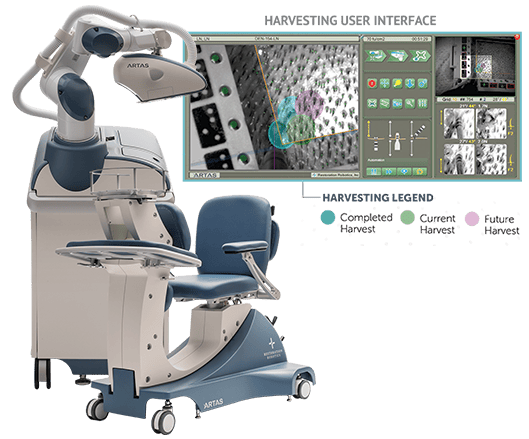No Stitches, No Linear Scar
As popular as hair transplants are getting, nobody likes stitches or the scars that are left after the hair transplant. When it comes to hair transplant surgery ARTAS is the way to go. Who ever thought, a robot performing hair surgery. With the ARTAS you don’t have to worry about stitches, and better yet NO linear SCAR!!

ARTAS Who?
The ARTAS Robotic System was created by Restoration Robotics in 2002 for the treatment of hair loss. Great news, the ARTAS Robotic System is FDA cleared! It only gets better, Dr. Mark A. Bishara at The Paragon Plastic Surgery and Med Spa has performed hundreds of hair restoration surgeries using the ARTAS Robotic System. The ARTAS Robotic System utilizes follicular unit extraction (FUE). Not only dissection, The ARTAS has the ability to make recipient sites. The ARTAS Robotic System has the ability of identifying and selecting your best hair for harvesting. With digital mapping it has the ability to provide a consistent graft dissection. Scarring is very minimal, unnoticeable at that. The recovery period with ARTAS Robotic System is fast making it easier for you to get back to your normal activities quicker.
ARTAS Animation
Behind the scenes of The ARTAS Robotic System
The day of surgery here at The Paragon Plastic Surgery and Med Spa we bring the patient in and start off with consents and paperwork. The day prior to surgery Dr. Mark A. Bishara will have some medications called and the patient will bring them along the morning of surgery. Dr. Mark A. Bishara’s staff will then begin to prep the patient beginning with trimming the patient hair so that it is easier for the ARTAS Robotic System to identify and extract. The patient’s donor area is numbed using local anesthesia. The patient will then be seated in prone positon as we prepare the ARTAS Robotic System. A tensioner is placed on the patient scalp to help with dissection and depth. Dr. Mark A. Bishara then begins to maneuver the ARTAS Robotic System. The ARTAS Robotic System will start capturing images of the patient’s donor area in order to identify the different angles and density of the patient’s hair. The dissection begins, as the ARTAS Robotic System is dissection Dr. Mark A. Bishara’s tech will go behind and manually extract the the follicular units as the ARTAS Robotic System disects. Once all follicular units are dissected and extracted, Dr. Mark A. Bishara’s techs will begin to manually transplant the new hair in to the patient’s recipient area. Before you know it, you’ll be walking out with a new hair set!
LEARN MORE ABOUT OUR ARTAS Robotic Services SERVICES, PLEASE CONTACT US (817) 473-2120 OR EMAIL APPOINTMENTS@MARKBISHARAMD.COM









